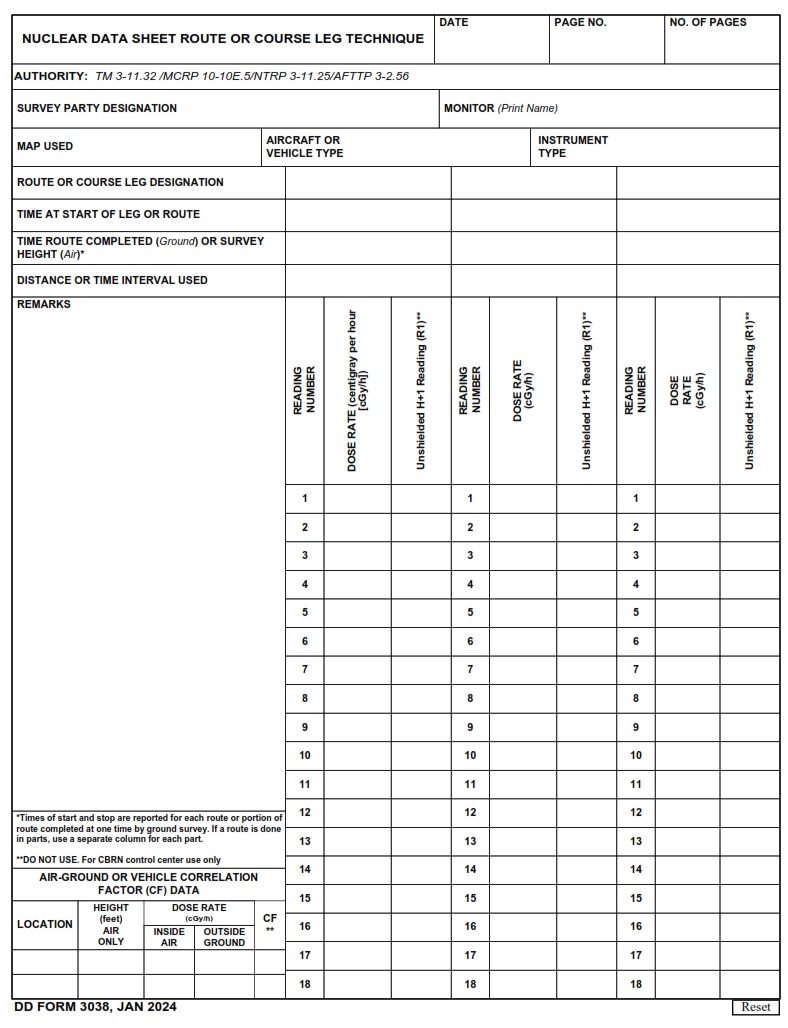Table of Contents
FREE-ONLINE-FORMS.COM – DD Form 3038 – Radiological Data Sheet – Route or Course Leg Technique – Navigating through the complex world of radiological data can be a daunting task for many, but fear not, for the DD Form 3038 – Radiological Data Sheet – Route or Course Leg Technique is here to guide you through the intricate web of information. Just like a seasoned explorer mapping out a course through uncharted territory, this form acts as your trusty compass in understanding and interpreting radiological data with precision and accuracy. Imagine yourself embarking on a journey where each route or course leg is carefully charted out, ensuring that you reach your destination of knowledge safely and efficiently.
Picture yourself as a detective deciphering clues in a mysterious case; the DD Form 3038 serves as your magnifying glass, allowing you to uncover hidden insights within radiological data. In a world where information overload is rampant, this form streamlines the process by providing a structured approach to analyzing radiation levels along specific routes or course legs. So buckle up, dear reader, as we venture into the fascinating realm of radiological data with the help of DD Form 3038 – guiding us like an expert pilot navigating turbulent skies toward clarity and understanding.
Download DD Form 3038 – Radiological Data Sheet – Route or Course Leg Technique
| Form Number | DD Form 3038 |
| Form Title | Radiological Data Sheet – Route or Course Leg Technique |
| Edition Date | 1/1/2017 |
| File Size | 56 KB |
What is a DD Form 3038?
The DD Form 3038, also known as the Radiological Data Sheet – Route or Course Leg Technique, is a critical document used by military personnel to plan and conduct operations in environments that may be contaminated with radioactive materials. This form provides essential information on radiation hazards along specific routes or course legs, helping commanders make informed decisions to minimize exposure risks for their troops.
One key aspect of the DD Form 3038 is its detailed data on radiation levels, contamination sources, and protective measures that can be implemented during missions. By utilizing this form, military leaders can strategically navigate through potentially hazardous areas while safeguarding the health and safety of their personnel. Overall, the DD Form 3038 serves as a vital tool in ensuring that radiological risks are effectively managed during military operations.
Where Can I Find a DD Form 3038?
If you’re in search of a DD Form 3038, specifically the Radiological Data Sheet for Route or Course Leg Technique, look no further than official military channels. One of the primary sources where you can obtain this form is through the Defense Logistics Agency (DLA) website or by visiting your local military installation’s administrative office. Additionally, some specialized military supply stores may also carry these forms for purchase.
It’s important to note that due to the sensitive nature of radiological data and information contained within these forms, access may be restricted to authorized personnel only. Therefore, it is advisable to ensure that you have the necessary permissions and clearances before attempting to procure a DD Form 3038. By following the proper protocols and channels designated by the military, you can acquire this essential document for use in your operational needs without any hassle.
DD Form 3038 – Radiological Data Sheet – Route or Course Leg Technique
As nuclear technology continues to advance, the importance of accurate radiological data collection cannot be overstated. The DD Form 3038, specifically designed for the Route or Course Leg Technique, plays a critical role in ensuring that radiation exposure risks are minimized during military operations. By meticulously documenting radiation levels along specific routes or course legs, military personnel can make informed decisions on the best paths to take in hazardous environments.
The use of the Route or Course Leg Technique in conjunction with the DD Form 3038 not only enhances operational safety but also provides valuable data for future missions. By maintaining detailed records of radiation levels at various points along a route, military planners can adapt strategies to minimize exposure and ensure mission success. This proactive approach demonstrates a commitment to safety and effectiveness that is essential in modern military operations involving potential radiological hazards.
